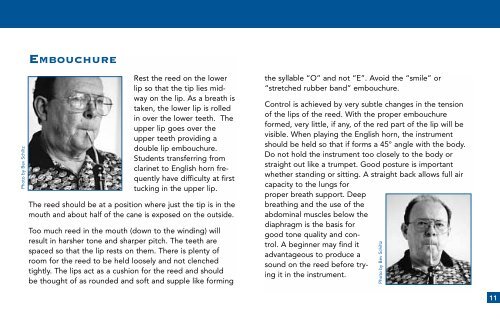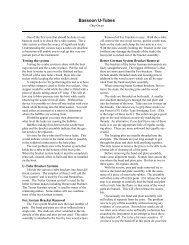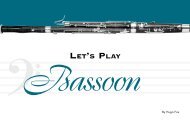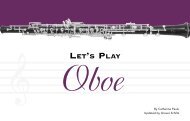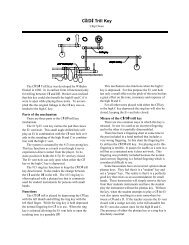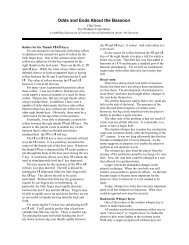English Horn playing guide pdf - Fox Products
English Horn playing guide pdf - Fox Products
English Horn playing guide pdf - Fox Products
You also want an ePaper? Increase the reach of your titles
YUMPU automatically turns print PDFs into web optimized ePapers that Google loves.
Photo by Bev Schiltz<br />
EMBOUCHURE<br />
Rest the reed on the lower<br />
lip so that the tip lies midway<br />
on the lip. As a breath is<br />
taken, the lower lip is rolled<br />
in over the lower teeth. The<br />
upper lip goes over the<br />
upper teeth providing a<br />
double lip embouchure.<br />
Students transferring from<br />
clarinet to <strong>English</strong> horn frequently<br />
have difficulty at first<br />
tucking in the upper lip.<br />
The reed should be at a position where just the tip is in the<br />
mouth and about half of the cane is exposed on the outside.<br />
Too much reed in the mouth (down to the winding) will<br />
result in harsher tone and sharper pitch. The teeth are<br />
spaced so that the lip rests on them. There is plenty of<br />
room for the reed to be held loosely and not clenched<br />
tightly. The lips act as a cushion for the reed and should<br />
be thought of as rounded and soft and supple like forming<br />
the syllable “O” and not “E”. Avoid the “smile” or<br />
“stretched rubber band” embouchure.<br />
Control is achieved by very subtle changes in the tension<br />
of the lips of the reed. With the proper embouchure<br />
formed, very little, if any, of the red part of the lip will be<br />
visible. When <strong>playing</strong> the <strong>English</strong> horn, the instrument<br />
should be held so that if forms a 45° angle with the body.<br />
Do not hold the instrument too closely to the body or<br />
straight out like a trumpet. Good posture is important<br />
whether standing or sitting. A straight back allows full air<br />
capacity to the lungs for<br />
proper breath support. Deep<br />
breathing and the use of the<br />
abdominal muscles below the<br />
diaphragm is the basis for<br />
good tone quality and control.<br />
A beginner may find it<br />
advantageous to produce a<br />
sound on the reed before trying<br />
it in the instrument.<br />
Photo by Bev Schiltz<br />
11


